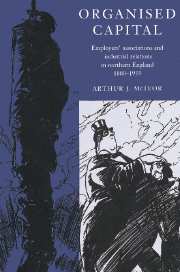Book contents
- Frontmatter
- Contents
- List of maps and tables
- Acknowledgements
- List of abbreviations
- Introduction
- Part 1 Setting the scene
- Part 2 Forging employers' organisations, 1880–1920
- 3 Organisation, membership and solidarity
- 4 Strikebreaking
- 5 Collective bargaining and procedural control
- 6 The impact of the First World War
- Part 3 Reacting to the economic slump, 1920–39
- Conclusion
- Bibliography
- Index
6 - The impact of the First World War
Published online by Cambridge University Press: 14 October 2009
- Frontmatter
- Contents
- List of maps and tables
- Acknowledgements
- List of abbreviations
- Introduction
- Part 1 Setting the scene
- Part 2 Forging employers' organisations, 1880–1920
- 3 Organisation, membership and solidarity
- 4 Strikebreaking
- 5 Collective bargaining and procedural control
- 6 The impact of the First World War
- Part 3 Reacting to the economic slump, 1920–39
- Conclusion
- Bibliography
- Index
Summary
The war emergency dislocated product and labour markets, radically altering the social and political environment in which employers' organisations operated. This produced conflicting and paradoxical results. The volatility of product and labour markets increased intra-class competition, undermining solidarity as competition intensified for scarce labour, for raw materials and for government contracts. Labour was directed into the armed forces and into war-related work, producing radical changes in the employment profiles of British industries. The effects of war upon product and labour markets were perhaps the main destabilising agents, setting in train forces which fractured internal discipline, undermined central control over wages and conditions, making consensus collective action more problematic. This was particularly marked, as one might expect, in the engineering sector, where, McKinlay, Wigham and Zeitlin have argued, employer cohesion waned and central authority atrophied between 1914 and 1920, resulting in a diminution of managerial rights and the adoption of a flexible, conciliatory, rearguard defensive policy by the EEF.
On the other hand, unprecedented government intervention in industry, combined with a quite remarkable surge in trade union growth and shop-floor labour militancy during the period 1914–20 placed great pressure upon individual employers, raising the capacity for collective action amongst industrialists. Hence, these years witnessed a counter-surge in the number, representativeness and stability of British employers' organisations, at all levels, peaking in the early 1920s. Moreover, many employers' organisations acted, often quite aggressively, though with varying degrees of success, to bring the destabilising influences, especially of the period 1914–17, under some control.
- Type
- Chapter
- Information
- Organised CapitalEmployers' Associations and Industrial Relations in Northern England, 1880–1939, pp. 146 - 180Publisher: Cambridge University PressPrint publication year: 1996

